Don't tie flies - if you want easy access to tons of flies. - if you want to save money on flies.
Don't tie flies
- if you want easy access to tons of flies.
- if you want to save money on flies.
- unless you live alone.
- unless you have an understanding partner and/or family.
- if you want to appear cool to the opposite sex.
Tie flies
- if you want something to do off-season.
- if you want to fish the best.
- because you like being creative.
- because you want to spend many great hours alone or with friends.
Two main reasons
Why would you want to tie flies?
Condensed from the above I see two main reasons:
1) To get the exact flies that you want, tied to the specs you want and looking as you want them to look.
2) To have a great pastime, a hobby, an activity to keep focus on fishing when there is no fishing.
Why wouldn't you tie flies?
Well, there's no reason not to if you ask me - in spite of the title and the intro to this article. I think that fly-tying is a very natural sidekick to fishing, but you might not want to embark on the journey: spending time and money on tools and materials, learning to tie well enough to satisfy yourself and not least spending the time tying.
I know fly anglers who have never tied a fly. They are few, but they do exists. I actually think I know more tyers who rarely fish, but tie a ton of flies, and with some fairness can be called fly-tyers more than fly-fishermen.
I think that fly-tying is a very natural sidekick to fishing
You will NOT save money
Do not embark on the fly-tying adventure to save money on flies, let alone to make money on tying.
You will NOT save money, but on the contrary have a lot of expenses that you didn't have before. If you want to save money, buy your flies. It might seem expensive at a glance, but the expenses are nothing compared to the money you will spend on tools, hooks and materials if you get smitten by the tying virus.
Making money from fly tying might seem an attractive potential, but hesitate and think before you quit your day job. Professional fly-tyers are few and far between, and none of them have become millionaires or even moderately wealthy from tying. Some can make a living, but doing that means tying a lot of flies (A LOT!) and can be compared to all other "creative" jobs gone professional: cooking, taking pictures, gardening, playing music. What attracted you to the art and craft might very soon become the very thing you hate about doing it, and the romantic image of somebody turning their favorite hobby into a livelihood soon turns into a daily routine of doing boring, repetitive chores under stressful conditions and mostly with a deadline. And unless you become highly successful - a rock star in your field so to say - you won't even get paid well.
The far majority of flies that you can buy in shops are tied by low wage African and Asian tyers whose relation to fly-fishing is as a Chinese seamstress' relation to fashion.
Getting started
If you decide to give fly-tying a go, do these two things:
1) Spend money. Get the proper tools and the proper materials. Don't skimp on the quality of either. Buying cheap in the beginning will just mean buying twice and will end up being more costly than spending the proper amount right away.
Buying cheap will also make learning much harder. It's very much easier to tie with good tools and good materials.
2) Get tuition. Sign up for a course, join a club, tie with friends. You can't learn proper fly tying from books or videos. You need a human instructor, and first and foremost you need someone to critique your products. No book or video will give you feedback on your own tying or give you tips specifically for your situation. And no book or video will borrow you a good bobbin holder or let you dig into their stash of good hackle.
Do not buy a kit!
There might be kits out there, which are good, but I haven't seen them. All the kits I have seen have really lousy tools and even the best ones have had mediocre materials.
Let me repeat: Don't buy a kit, period!
The flyshop may push one, and make it look like the best deal you can imagine, and to you as a beginner it might look like the best deal ever, but in reality a few items may be OK while the vast majority is close to useless - tools and materials. You get a lot that you don't need, and will miss important items. Add to that that the quality of both tools and materials is rarely even average and generally downright lousy.
Hand pick tools and materials in stead, and start slowly by buying exactly what you need and just a few good items.
Let me repeat: Don't buy a kit, period!
What you need
This list might not be the list that every seasoned fly-tyer on the planet would compile, but it's a pretty good starting point for the beginning fly-tyer. Depending on what you're tying, you might need or want something not on the list, but it will get you started in a good way.
Tools
When it comes to tools, don't necessarily buy the very best, which is often also the most expensive, but buy the best value. And buy to keep. Most tools can last a lifetime if selected and treated properly.
A vise. Buy a good quality vise from a renown manufacturer. Don't think you can save a lot here.
If you buy right, you have a vise for a lifetime.
If you buy wrong you will buy another vise within a year or two like this Reddit-poster who learned the lesson the hard way.
If I were to buy today I'd buy a Renzetti Traveller or a Snowbee Waldron vise. The Waldron is the most expensive at GB£ 299.- or about 450.- US$. Expensive, but also very nice. The Renzetti is about half that, and can typically be had for 200.- US$, which makes it very high value for the money. The Griffin Blackfoot Mongoose and the Peak Vice are even less expensive, and seem to be OK alternatives. I haven't tried them, but they look good.
I would personally never buy anything but a well built, truly rotating vice. I wouldn't buy a "Regal style" vice with spring loaded non-rotating jaws. Lots of good flies are tied on Regal vices, but not on my tying table.
Bobbin holder(s). I'd buy two or three good bobbin holders from the start, but you can of course do with one if you don't mind changing thread.
Simple, high quality, ceramic is the recipe here.
I have used Griffin's ceramic bobbin holders for years, and have been very pleased with them. They are about 12.- US$ a piece. Other manufacturers like Dr. Slick, Veniard, Renzetti all have some excellent models that aren't too expensive at about 10-15.- US$ each, but you can get decent no-name ceramic bobbin holders for about half that price.
Don't buy cheap Indian or Chinese ones. Just don't. I would personally also stay clear of all the models with tension adjustment, "automatic" in the name or any other construction than the simple and classic. Some makes are very expensive such as Pettitjean, C&F and a few others. They aren't bad, but definitely not 5-10 times better than the plain ones, even though the price indicates it.
There's MUCH more about bobbin holders here.
Simple, high quality, ceramic is the recipe here.
Scissors. A good pair of scissors need not be very expensive. They just need to be able to cut - like in cut and not shear or tear.
There's a wealth of options, but if you spend about 15-20 US$ on a pair, you will most likely be fine. Dr. Slick is a very safe bet here at reasonable prices.
I'd personally go for a pair with short, straight jaws and one serrated blade, which makes it grab onto the material, and makes cutting bunches of hair a lot easier.
There's MUCH more about scissors here.
Small tools. You will need a bodkin (AKA a dubbing needle) or two. Just buy a cheap one in your fly shop and get one that has a hole in the back end for tying half hitches.
Get a bobbin threader. It's a cheap tool and a great help for threading the bobbin holders.
You can make yourself both a bodkin and a threader using dowel wood and a needle and some mono.
You can also make yourself a Velcro stick and also shave down a tooth brush, and also make a bodkin cleaner from a small lidded plastic container or bottle and a bit of steel wool.
If you need hackle pliers, buy some decent ones, but leave the really expensive and intricately constructed ones on the shelf in the shop. Lots of fly-tyers also use cheap wire clips made for electronics.
A whip finisher might also be a good tool to have. I personally use my hands and don't even own one, but some tyers swear by them.
If you will be tying with wire and bead chain, you need a pair of cutters. If your home toolbox doesn't contain a cutter already, buy an inexpensive set in a hardware store. Get a small side cutter and a set of small needle nose or flat nose pliers.
A hair stacker is also nice to have for stacking wings and tails. Buy simple and inexpensive metal stackers useful for the size and type of flies you want to tie. A dubbing twister is also a cheap investment. A simple brass model with no frills is fine, the fancier models with a shaft and a bearing are nice if you want to spend the money.
If you expect to tie a lot with hair - like Arctic fox and deer hair - a comb will be nice too. A simple plastic hair comb will do.
Materials
There's no single materials list that will give you what you need because the selection depends on what you will be tying. But there's a strategy that will ensure that you get something useful and omnipotent, which can be used for many different flies.
I usually recommend people selecting a few patterns or even a single one, that they can start out with.
For those who have no idea, here's a place to start. The list below takes its vantage point in a particular style of flies, and buying from that list will get you something that can produce many patterns from the outset, and just one or two more materials can expand the range of potential patterns significantly.
After having bought the initial collection, you can slowly stock up on materials depending on the patterns you want to tie. If you tie together with others, you can always borrow or swap and get access to even more materials.
The same thing applies for materials as for tools: DO NOT BUY A KIT! Simple as that. I'm not saying that there aren't any decent material kits out there, but 90% of the kits I have seen contain mediocre - oftentimes lousy - materials, and are certain to contain something you don't need and miss something you need. Simply don't.
Like with the tools a few good, hand picked items will bring you far.
Sharing
Buying in large quantities makes the single item price lower, but the expenses higher, but buying bulk might not be completely out of the question. Buy together with some friends and split. That goes both for hooks and materials.
Expensive materials such as dry fly saddles can be shared. Buy a grizzly and cut it in two, or buy both a grizzly and a brown and split them both. The same thing can be done with skin patches, deer hair, fox tails and many other materials. That will enable you to keep expenses down and still get some good and varying materials.
It also makes sense to buy ten packs of dubbing or flash or ten cheap necks when they are on offer and share with fellow tyers.
Hooks
If you intend to fish with your flies - and I'm almost certain that you do - you will want some decent hooks. Hooks can be expensive, but look out for the less expensive brands and also go through bargain bins to find useful deals.
Buy strategically and just what you need. You might not need all sizes of several hook shapes, and you might not need both down eye and up eye dry fly hooks, or standard and long shank streamer hooks or several curve shapes in your nymph hook selection.
Buying hooks is also a place where large packages makes sense if you have someone to share with.
Buying few hooks at the time means less expenses than buying a lot, but will of course increase the price per hook. Boxes typically come with 10, 25, 50 or 100 hooks, and you can even buy 500 or 1000 hooks bulk, which really lowers the price, but certainly raises the overall expenses. But if you are a handful of tyers buying together 500 hooks to share isn't that many.
Usually the 25 or 50 piece boxes are the best option for the beginner and a fair compromise with regards to price.
Don't be a slave to pattern descriptions, thinking that only the hook mentioned will do. Buy and use generic hooks and select from what you have to suit the pattern best.
Free materials
As a fly tyer you might as well start a good habit right away: always be on the lookout for fly-tying material.
Foam, yarn, wire, flash, rubber, plastic, fur scraps and much, much more can be used. Once you start focusing, you will find many useful materials in craft and hobby stores and even in your own home.
Some materials might seem obvious freebies like thread and wire, but be very selective. Sewing thread does not make good fly-tying thread and most craft store copper wire is way thicker than the wire normally used for smaller flies like nymphs.
Once you get a grasp of the character and quality of fly tying material, you will be able to spot useful materials when you see them.
You can also dig out some waterproof markers for adding color to the finished flies. Black, blue, green and red can be handy, but should you have some in earth colors like tan, dull orange, brown and olive they can be very useful.
The first materials
In the lists below you see what I would fill in my box (or actually yours. Mine is already more than full...) depending on what flies I intended to tie. The colors mentioned are just suggestions. You can buy some, all of them or more depending on your budget and ambitions.
If you have one or some specific patterns that you want to tie, they might call for something that's not in my lists, and you can just adjust your own shopping list accordingly.
General materials
Most fly tyers will need or find use for these materials:
Clear varnish (AKA head cement)
Super glue
Dubbing wax
Depending on fly type
Below you will find some loose suggestions to materials you can buy or acquire depending on what you are tying. The list gives some general suggestions and a color specter, but is of course neither definite nor correct for everybody. But if you are completely lost, it gives you a place to start.
Dry flies
Tan
Olive
Brown
Gray
White
Grizzly
Dry fly light wire hooks in the 10-12-14-16 range
8/0 tying thread (black, tan, brown)
Good quality grizzly dry fly saddle hackle (or a half grizzly and a half brown)
Dry fly dubbing (tan, gray, olive)
Natural CDC feathers
Fine deer hair
Antron yarn (white, tan, light gray)
Peacock herl
Free materials: yarn scraps, thin foam, paintbrush bristles
Adams, Klinkhamer, CDC&Elk, EHC, Griffith's Gnat, lots of generic dry flies
Nymphs
Tan
Olive
Brown
Black
Curved and straight heavy wire nymph hooks in the 10-12-14-16 range
8/0 tying thread (black, brown, olive)
Brass bead heads
Wire or foil weight (tungsten)
Hare's mask
Dubbing in various useful colors (tan, brown, olive)
Copper, silver and gold wire (no, it's not real silver and gold!)
Peacock herl
Pheasant tail
Partridge skin
Goose biots, (black, brown, red)
Free materials: yarn scraps, plastic string, plastic bags, lead and metal foil, thin metal wire, small pearls
Saywer's PTN, Hare's Ear Nymph, Beadhead Nymph, various generic nymphs
Wet flies
Black
Gray
Tan
Brown
Olive
Red
Claret
Yellow
8/0 tying thread, black
Traditional wet fly hooks in the 6-8-10 range
Dubbing in assorted colors (black, claret, brown, tan, grey)
Hen saddles (natural colors, black, claret, olive)
Flat medium tinsel (silver/gold)
Oval medium tinsel (silver, gold)
Peacock herl
Pheasant tail for wings
Golden pheasant tippet
Various stiff feathers like duck and goose for wings
Barred duck feathers for wings
Partridge skin
Yarn scraps (red, yellow, orange, olive)
Flymphs, spider flies, traditional wet flies like March Brown, Coachman, Greenwell's Glory, Zulus, Bumbles
Salmon flies
Black
white
Blue
Red
Green
Yellow
Beiss
Orange
Rust
6/0 tying thread, black
Salmon and streamer hooks in the 2-4-6 range (you can also opt for tubes)
Arctic fox or similar hair (assorted colors, black, yellow, blue, orange, beiss)
Synthetic floss (black, bright orange, chartreuse)
Flash (pearl, copper)
Cheap Indian/Chinese necks (black, red, blue, yellow, green)
Grizzly hen skin
Golden Pheasant skin (with tippet and crest, optionally tail)
Zonker strips or tanned rabbit skin (black, "dirty" colors)
Squirrel tail (white tipped, brown, red squirrel)
Flat medium tinsel (silver/gold)
Oval medium tinsel (silver, gold)
Dubbing (black, red, yellow, blue, green)
Sunrays, Red and Green Butt, Undertaker, Ullsocken, Francis, Rat flies, generic hair winged flies
Steelhead flies
Pink
Purple
White
Orange
Chartreuse
6/0 tying thread, black
Salmon and streamer hooks in the 2-4-6 range, shanks, stinger hooks (again tubes is an option)
Brass beads, dumbbell eyes
Arctic fox or similar hair (assorted colors, black, light blue, orange, pink, purple)
Cheap Indian/Chinese necks (black, light blue, orange, pink, purple)
Marabou (black, chartreuse, pink, purple)
Zonker strips or tanned rabbit skin (black, light blue, orange, pink, purple)
Flash (pearl, blue, pink, purple)
Rubber legs (black, light blue, orange, pink, purple)
Dubbing (black, blue, chartreuse)
Intruders, zonkers, leeches, Popsicles
Bass flies
Red
Black
White
Green
Chartreuse
Yellow
Medium wire wet fly hooks in the 2-4-6 range
6/0 tying thread (black, white)
Foam (white, black, yellow, green)
Rubber legs (white, you can dye them with markers)
Dumbbell eyes
Natural bucktail (brown/white, chartreuse, yellow, red)
Cheap Indian/Chinese necks/saddles (black, white, olive)
Natural deer hair for spinning
Marabou (assorted colors)
Flash (assorted colors)
Flash chenille (assorted colors)
Free materials: foam blocks and sheets, Styrofoam
Clouser Deep Minnow, Wooly Buggers, various bass bugs
Pike flies
White
Chartreuse
Orange
Red
Black
Grizzly
6/0 tying thread (black, white)
Streamer hooks in the 1/0-6/0 range
Cheap Indian/Chinese saddles (red, chartreuse, white, olive, yellow)
Bucktail (natural, chartreuse, red, yellow)
Flash (assorted colors)
Flash chenille (assorted colors)
Stick-on eyes
Foam popper heads
Free materials: Christmas ornaments, party wigs, doll's and toy hair, foam (discarded flip-flop sandals, packaging)
Flash streamers, Splayed-alive-pike fly, Pike Duster, poppers, various generic pike flies
Saltwater flies (Baltic)
Gray
Tan
Black
Brown
Copper
Red
Pink
Grizzly
Streamer or stainless hooks in the 2-4-6 range
8/0 tying thread (black, tan, red)
Copper wire
Low grade grizzly dry fly saddle
Cheap Indian/Chinese necks/saddles (hen and rooster, natural undyed colors, brown, tan, grey)
Golden Pheasant skin (without tail and crest)
Peacock herl
Hare's mask
Flash (pearl, red, orange, straight and twisted)
Flash dubbing AKA Angel Hair (copper, silver, pearl, pink)
Free materials: Different yarn scraps, bead chain and thick mono for eyes
Frede, Magnus, Omoe Brush, generic shrimps and streamers
Saltwater flies (Atlantic)
Blue
Olive
Black
White
Chartreuse
Streamer or stainless hooks in the 1/0-1-2 range
6/0 tying thread (white, black)
Saddle feathers (grizzly, natural colors, blue, chartreuse, olive)
Bucktail (white, blue, chartreuse)
Synthetic hair (white, blue, black, olive, red)
Flash (translucent, assorted colors and structures)
Peacock herl
LCR
Stick-on eyes
Free materials: Different yarn scraps, bead chain, foils
Lefty's Deceiver, Clouser Deep Minnow, generic baitfish, shrimp and squid patterns
Saltwater flies (tropical, bonefish)
Tan
Gray
White
Pink
Brown
Grizzly
Good stainless hooks in the 2-4-6 range
Dumbbell eyes
6/0 tying thread (black, tan, pink)
Low grade grizzly saddle
Craft fur, doll's hair (tan, white, pink, gray)
Flash (translucent, assorted colors)
LCR
Free materials: Bead chain, doll's and toy hair, thick mono for eyes
Crazy Charlie, Gotcha, generic crab and shrimp patterns
Saltwater flies (tropical, larger fish)
Black
White
Red
Chartreuse
Good stainless hooks in the 2-1-1/0-2/0 range
6/0 tying thread (black, white, chartreuse)
Saltwater saddle feathers (grizzly, chartreuse, black, red)
Zonker strips (black, red, chartreuse)
Marabou (black, red, chartreuse)
Flash (translucent, assorted colors)
Poly Yarn (chartreuse, yellow, tan)
LCR
Free materials: Bead chain, doll's and toy hair, yarns
Cockroach type flies, Bunny flies, Black Death, Toad flies, various generic tarpon flies
I know that there are more fish and many, many more materials that you can get, but this will start you off with a decent collection of materials, which is bound to grow if you get smitten by the germ. Select carefully when you shop. Buy good quality. Buy full skins or skin patches rather than bags of loose material like hair dubbing or feathers.
As your material collection grows, so does your potential range of flies, and soon you will have what's needed for most of the flies you want to tie, and only need few new materials to tie the rest.
- Log in to post comments








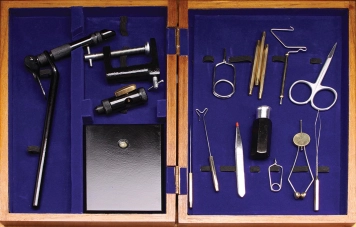










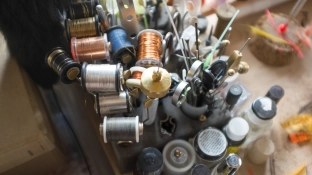
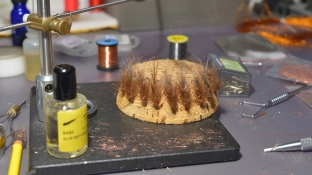
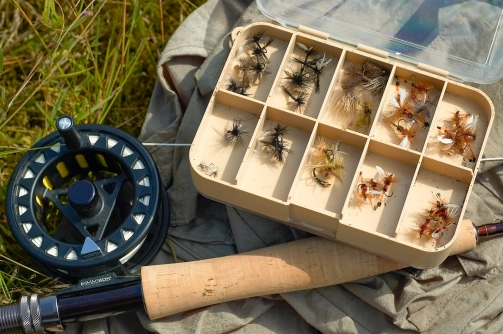












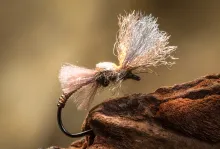

Good comments for us
Good comments for us beginners...I always feel that quality beats quantity every time. I would rather have 5 flies that work, than a box full of nice nice stuff. I have been tying flies for a year now and I still do a lousy job but I am damned if I will quit, I have some friends who never pull punches when I show my stuff, they all say I stink, but I have caught fish on mine and somehow I still love to tie...beats sitting around watching TV all of the time. So as I always say : " Fish, watch out, I am a comin' you don't stand a chance"
Don.
I think a few other
I think a few other good patterns to try are elk hair caddis, compara dun and x caddis, wulffs are good too. These require hair and not much hackle and they are fairly economical to make. Picking simple flies like wooly buggers teaches you skills and how to work with materials. I also would avoid fashion flies with hot materials or foam and glue starting out. Focus instead on skills and learning. Makes 6s or dozens of all. Cheap tools are better than no tools and crap is still crap. The very best bang for the buck of vises is the Danvise. I tie on a Regal as I hate ***ckin' little set screws and bitty levers that don't lock hooks. Most of the rotatory functions are worthless. I've owned several and never use the rotatory stuff, then again, my first premium vise was an HMH, I still have 30 years.
Not all kits are worthless
While in principle I agree that kits aren't usually the way to go, I have found one or two that are worth it, especially of you think of them as "Explore Fly Tying" kits. I dropped maybe $60 for a small tool kit (vise, scissors, bobbin, bodkin, threader, hackle pliers) and a very basic Wapsi materials kit. Are they great? No, I have replaced the vice and bought an additional bobbin. however it was enough tools and materials to get and keep me going until I figured out what I wanted to spend my money on. I wouldn't have gotten into fly tying if I had to start with a $160 Renzetti Traveler vise.
Fly tying consistency
Epic article! Just my personal take on fly tying consistency: over-rated!!!!!
Only because the bugs I see on the tailwater rivers I fish are never consistent either. So, I never worry about consistency and end up the minor variations that I encounter.
Tying Stations
While this comment is for the more seasoned tiers, a good tying area is very helpful. Once you find yourself immersed in the art, you will be up to your ears in material. Having a place to store your material close at hand with a good surface is priceless. I've seen a lot of good options but personally, I love my TieCraft Desk. Integrated bobbin storage, built in waste baskets and storage close by is great. Plus, my wife isn't yelling at me about my messy desk :D